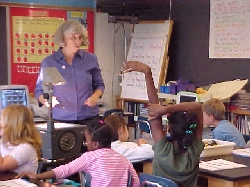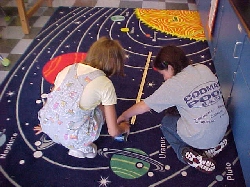|
 Mrs. Terry Green is a science specialist, teaching Grades 1-4 science at The Lincoln School in Lincoln, M.A.
She has been in this position, typically teaching about 350 children during the week, since she returned to
teaching in 1994. Mrs. Terry Green is a science specialist, teaching Grades 1-4 science at The Lincoln School in Lincoln, M.A.
She has been in this position, typically teaching about 350 children during the week, since she returned to
teaching in 1994.
For the past five years she has been actively teaching engineering skills to both the children and staff at
the Lincoln School. Terry also coordinates a very active Lego program at the school. In this program she
interacts with teachers in grades K-5, supporting them with the materials, technology and concepts as they
use Lego bricks as the primary manipulative while doing engineering.
"The engineering process is a natural one in our school," says Terry. "The collaborative nature of the
process with the revise, test and rebuild is one of the ways teachers work at the Lincoln School. Adding it
to the work we do with children was a natural fit."
How do the students respond to these engineering-based lessons? "They love it! Many are surprised when I
call them 'engineers'. I think the program breaks some of the stereotypes associated with the name," she says.
In particular, her students like the hands-on part of the process, the testing, learning from the test,
redesigning and re-testing.
Terry believes that including engineering has definitely changed the educational experience of her students.
She feels they are given very real, child centered problems to solve with a group of peers. The learning is very
active - always hands-on with a dependency on the technology involved.
"This technology piece is an important one," she says. "It was one that took the most time for me to learn, but one that comes naturally to the children I teach."
She also thinks it is important for children to see themselves not only as learners but also as teachers. It is her
hope that the children leave her classroom empowered with the tools they need to problem solve day-to-day problems in
their lives.
 Beyond the classroom, Terry has reached out to involve the parents. For the past three years she has run a Parents
Night with the same materials her students use. She finds that this has been very successful and it has generated
much interest in the Lego program. She runs the night as she would run a class, setting up teams of parents, presenting
the problem and then guiding them through the process of solving the problem. "I always learn so much from the parent
community, plus they get a hand-on learning experience like their children experience." She also finds this a good group
to recruit volunteers from that will come into the classroom to help with the children. Beyond the classroom, Terry has reached out to involve the parents. For the past three years she has run a Parents
Night with the same materials her students use. She finds that this has been very successful and it has generated
much interest in the Lego program. She runs the night as she would run a class, setting up teams of parents, presenting
the problem and then guiding them through the process of solving the problem. "I always learn so much from the parent
community, plus they get a hand-on learning experience like their children experience." She also finds this a good group
to recruit volunteers from that will come into the classroom to help with the children.
With all her experience in teaching engineering to students, the advice Terry offers to other teachers is, "Hang in
there and take risks! We constantly ask and expect our students to be risk takers. The best learning happens for me when
I am the most uncomfortable. When I first started I thought I don't know what to do with this stuff and I don't know
the answers to things I am asking students to do. Sometimes introducing a challenge in which you don't know the answer
produces the best results. Last year, in my simple machine unit, I had the children build catapults out of the Lego
blocks. I had no idea what to expect. The results were so fantastic and inspiring to me."
|